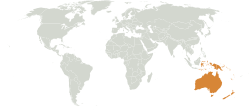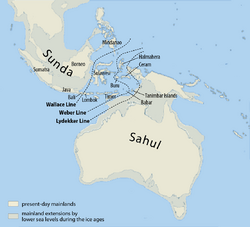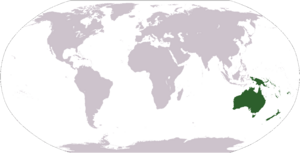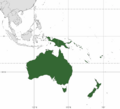Australasia facts for kids


Australasia is one of the world's great geographical regions. It is unified in natural history and geology because of its ancient origin as part of the supercontinent Gondwana. It is the geographical area which contains the Australasian ecozone.
Its islands are all south-east of the Bali–Lombok line, known as the Wallace Line, after Alfred Russel Wallace. The main political entities are Australia, Indonesia and New Zealand. The main islands are:
- Australia
- Flores
- Lombok
- Melanesia
- New Caledonia
- New Guinea
- New Zealand
- Sulawesi
- Sumbawa
- Tasmania
- Timor
Australasia's region is Oceania. It comprises Australia, New Zealand, the island of New Guinea, and neighbouring islands in the Pacific Ocean.
Physical geography
Physiographically, Australasia includes New Zealand, Australia (including Tasmania), and Melanesia: Papua New Guinea and neighbouring islands north and east of Australia in the Pacific Ocean. The designation is sometimes applied to all the lands and islands of the Pacific Ocean lying between the equator and latitude 47° south. Papua New Guinea also includes approximately 600 offshore islands.
Most of Australasia lies on the southern portion of the Indo-Australian Plate, flanked by the Indian Ocean to the west and the Southern Ocean to the south. Peripheral territories lie on the Eurasian Plate to the northwest, the Philippine Plate to the north, and in the Pacific Ocean – including numerous marginal seas – atop the Pacific Plate to the north and east.
Human geography
Geopolitically, Australasia sometimes refers to Australia and New Zealand together – in the absence of another word limited to those two countries; however, the two countries are sometimes referred to collectively as the Antipodes. Sometimes the term also encompasses the island of New Guinea (Papua New Guinea and the Indonesian part of the island). Many organisations whose names include the prefix "[Royal] Australasian Society of ..." limit their scope of operation to just Australia and New Zealand.

In the past, Australasia has been used as a name for combined Australia/New Zealand sporting teams. Examples include tennis between 1905 and 1915, when New Zealand and Australia combined to compete in the Davis Cup international tournament, and at the Olympic Games of 1908 and 1912.
Anthropologists, although disagreeing on details, generally support theories that call for a Southeastern Asian origin of indigenous island peoples in Australasia and neighboring subregions. The first human habitation of Australia is estimated to have occurred 50,000 or more years ago. These first Australians were the ancestors of the Aboriginal Australians, who form the majority of today's indigenous Australians. They were mostly hunter-gatherers and arrived via land bridges and short sea-crossings from present-day Southeast Asia.
Images for kids
-
Regions of Oceania
-
Australia's concept of Australasia, which includes Australia, New Zealand and, in this case, Melanesia
See also
 In Spanish: Australasia para niños
In Spanish: Australasia para niños




